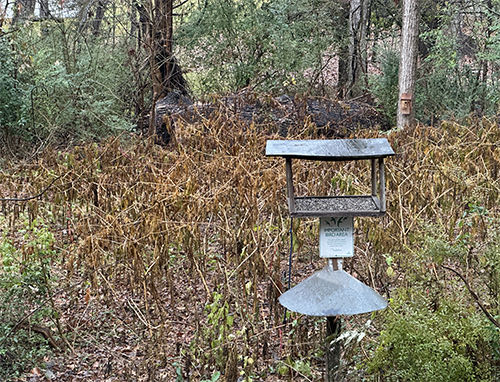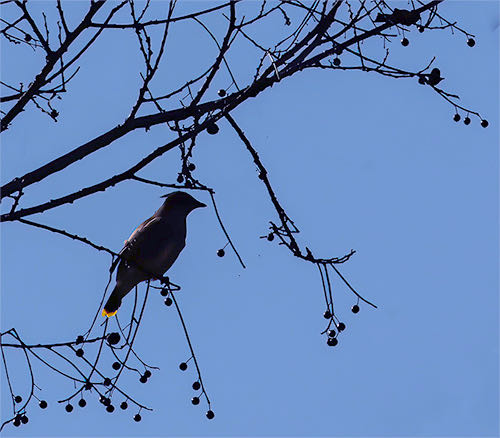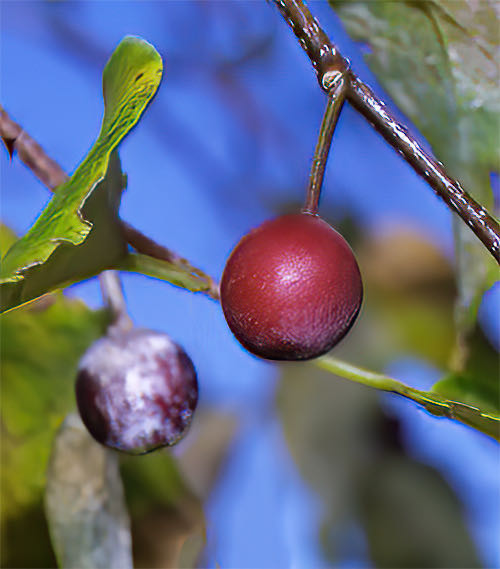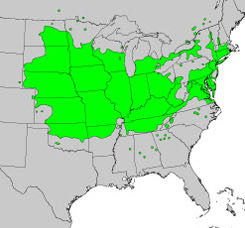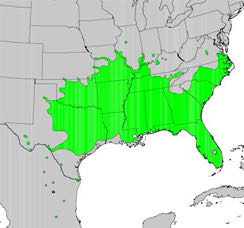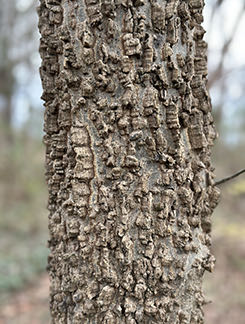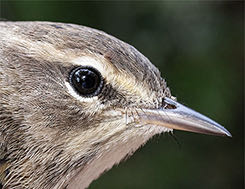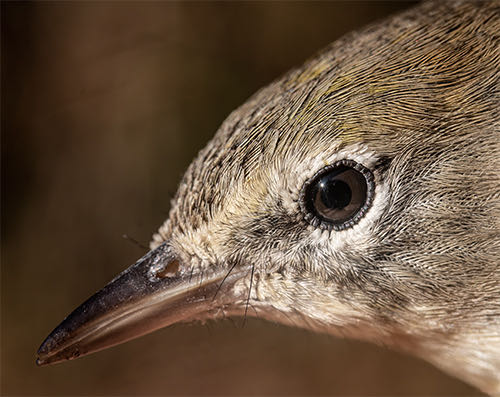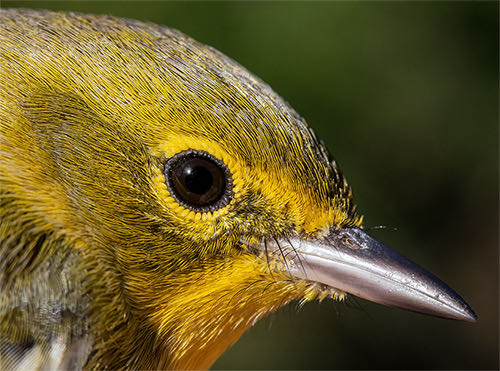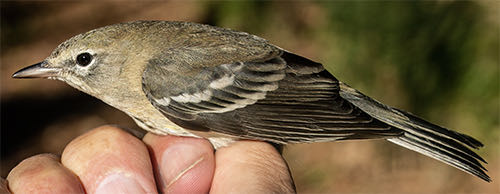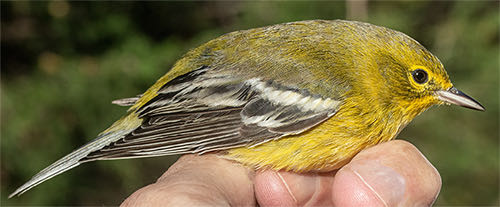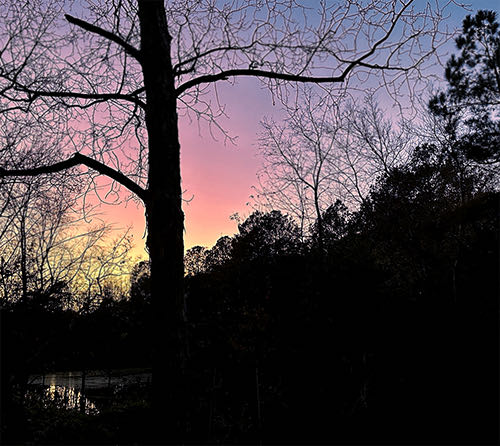- Established 1982 -HOME: www.hiltonpond.org
THIS WEEK at HILTON POND Subscribe for free to our award-winning nature newsletter (Back to Preceding Week; on to Next Week) |
Join Us for the |
|
(immature male Rufous Hummingbird at right) |
MOVING ON FROM PURPLE POKEWEED TO SWEET, SHINY SUGARBERRY We noted in a past photo essay that a prolific purple Pokeweed patch popped up this past summer around Hilton Pond Center, the purple-stemmed plant producing plentiful purplish fruits that prodded a peripatetic Cedar Waxwing population into a propensity to poop purple. For a couple of weeks in early November, waxwings periodically popped into the Pokeweed, pausing to purloin purple berries and periodically pass the seeds amid a plethora of purple droppings.
All text, maps, charts & photos © Hilton Pond Center Alas, all good things in nature must sooner or later come to an end, and by late November there were no more purple berries to attract the waxwings to our American Pokeweed, Phytolacca americana. Many of its fruits were consumed by waxwings (or other local species including Northern Mockingbirds), but some dropped to earth uneaten, perhaps to germinate next spring. Once-green pokeweed leaves--bitten by frost--are now shriveled and dark (above), dangling from formerly purple stems turned a deep golden brown.
All text, maps, charts & photos © Hilton Pond Center With their nutritious Pokeweed berries gone, what was our local waxwing flock to eat? These crested birds don't come to feeders, so our seed offerings were moot. Furthermore, American Robins had already stripped crimson fruit from our Flowering Dogwoods, and our local Eastern Red Cedars this year produced few of those tiny blue berries with which Cedar Waxwings are nominally associated. But guess what? The ravenous waxwings had one more treat awaiting them high in the canopy above Hilton Pond: Bite-sized, sweet-tasting fruit from Sugarberry trees (above).
All text, maps, charts & photos © Hilton Pond Center From our office window in the Center's old farmhouse we could see silhouetted against the sky the thin branches of several tall Sugarberries from which hung a cornucopia of quarter- to half-inch shiny reddish fruits that give the tree its name. And an appropriate epithet it is, since its sugar-laden berries (above) are so sweet they were used by Native Americans who beat the fruit to a pulp and then mixed it with animal fat, rolled it into balls, and roasted it in the fire. The resulting balls had a long shelf life and became nutritious food reserves. (Quote from the "Gardening Know How" web site.) Some folks say the taste is similar to that of dates.
Historical distribution of Northern Hackberry (above left) All text, maps, charts & photos © Hilton Pond Center We thought for a long time all these berry-yielding trees at the Center were Northern Hackberry, Celtis occidentalis, a species closely related to Sugarberry, C. laevigata. Both trees have warty bark (Sugarberry, below left) and make similar-looking fruit, but the historical distribution of C. occidentalis is to far north (see maps above). That said, both species sometimes can be found outside their natural range, planted by enthusiasts who wanted to attract winter birds to their yards.
All text, maps, charts & photos © Hilton Pond Center After careful examination of foliage on the trees at Hilton Pond, we determined we indeed had the more southerly Sugarberry (sometimes called Southern Hackberry), whose serrated leaves (above right) tend to be smooth-edged at the base. In fact, some Sugarberry trees bear leaves with few or no serrations at all. (NOTE: Although they are congeners, there doesn't seem to be any good evidence Sugarberries and Northern Hackberries hybridize or that there are intergrades where their ranges overlap, so leaf serrations seem to be a reliable identifier. In addition, mature Hackberry leaves have a sandpapery dorsal surface, while Sugarberry's are smooth.)
All text, maps, charts & photos © Hilton Pond Center These days as we look out toward Hilton Pond we can see a half-dozen towering Sugarberries; as might be expected from berry-producing trees--quite a few of their offspring have sprouted on the ground nearby. Such reproductive success pleases us--the trees also shade our office space from the bright sun of summer--but we suspect Eastern Bluebirds (above), Yellow-bellied Sapsuckers, Red-bellied Woodpeckers, and Cedar Waxwings find the trees even more important as they gobble up early winter Sugarberries against a clear blue sky.
All text, maps, charts & photos © Hilton Pond Center Incidentally, there's a non-bird group of organisms that are also attracted to either species of Celtis: The Lepidopterans. Yes, gravid female butterflies seek out both Hackberry and Sugarberry as host trees on which to lay eggs. After these hatch, hungry larvae get to work on the trees' foliage before metamorphosing into adults with names like Hackberry Emperor (above and below), Tawny Emperor, American Snout, Question Mark, and Mourning Cloak. We've seen caterpillars (and adults) of all five butterfly species at Hilton Pond, which may explain how by summer's end there are almost no undamaged Sugarberry leaves; nearly all show signs of being nibbled on by hungry butterfly larvae.
All text, maps, charts & photos © Hilton Pond Center POSTSCRIPT: After posting this installment about Sugarberry, we got an interesting e-mail from Bryan England, a long-time reader of This Week at Hilton Pond. Here's what Bryan said:
All text, maps, charts & photos © Hilton Pond Center MORE YELLOW-ISH WARBLERS We wrote a few weeks ago about how different in appearance are the two races of Palm Warbler (PAWA). Although both subspecies have bright yellow undertail coverts, the Western Palm Warbler (below left) is relatively drab while Yellow Palm Warblers (below right) lives up to their name. Representatives of either race breed far to the north across most of Canada and occur in the Carolina Piedmont primarily during migration.
All text, maps, charts & photos © Hilton Pond Center A few PAWA may overwinter here, but come cold weather Palm Warblers are far more common along the Carolina Coast southward to Florida and the Caribbean. (NOTE: We were pleased to hear from several readers who were confused by considerable plumage variation in the two Palm Warbler races and were glad to learn about the differences in that photo essay.)
All text, maps, charts & photos © Hilton Pond Center Due to considerable color variations, Palm Warblers can indeed be confusing, but there's another highly variable warbler that breeds across the eastern U.S. and winters from North Carolina southward to Florida and the Gulf Coast. We speak here of Pine Warblers (PIWA) whose plumage varies from drab (above) to eye-popping yellow (below). Although this parulid often surprises observers by showing up at suet feeders, we don't doubt hungry PIWA visit the Center's Sugarberry hoard to compete with Cedar Waxwings and other avian species for that nutritious treetop fruit.
All text, maps, charts & photos © Hilton Pond Center If their plumage varies considerably, how can one be sure at any time of year whether one is looking at a Pine Warbler? It's actually pretty easy if you take into account ALL the bird's field marks, as follows: First, as shown in the two images above there is a pale line through the eye, resulting an a partially broken eye ring. Note also a lighter spot in front of the eye and a rather stout bi-colored bill in which the upper mandible is darker.
All text, maps, charts & photos © Hilton Pond Center Next, look for a pair of prominent wingbars , as shown on this week's immature female PIWA (above) and by a just-captured adult male (below). Wingbars are present regardless of the overall color of body plumage. (Wingbars, by the way, are the tips of covert feathers that overlap bases of the next row of feathers, providing streamlining. The bottom wingbar in the photo below is incomplete because at least one of those white-tipped covert feathers is missing.)
All text, maps, charts & photos © Hilton Pond Center The final field mark to look for in a Pine Warbler is tail spots, in which the outer two rectrices on either side are adorned with white. These long pale markings are not always visible in lateral or top view, but they certainly show when the bird fans its tail, as below.
All text, maps, charts & photos © Hilton Pond Center So that's our primer on identifying a not-so-confusing winter warbler appearing at your suet feeder. If it's got a pale line through the eye, broken eye ring, bi-colored bill, white double wingbars, and white tail spots it's almost certainly a PIWA, regardless of how drab or bright yellow it might be. Although the palest birds are likely young females and the brightest older males, they're all Pine Warblers just the same. Some will depart Hilton Pond Center and fly back north come spring, but many will stay. Almost anywhere in the Carolinas with pine lands or mixed pine-hardwoods will host breeding Pine Warblers, from the Blue Ridge Province to the vast Coastal Plain. All text, maps, charts & photos © Hilton Pond Center HILTON POND SUNSETS "Never trust a person too lazy to get up for sunrise
All text, maps, charts & photos © Hilton Pond Center Sunset over Hilton Pond, 13 November 2022 Leaves are gone from the big Shagbark Hickory.
All text, maps, charts & photos © Hilton Pond Center Sunset over Hilton Pond, 21 November 2022 Rain clouds parted just in time for this lavender tableau. All text, maps, charts & photos © Hilton Pond Center Don't forget to scroll down for lists of Hilton Pond supporters and of all birds banded and recaptured during the period. Photoshop image post-processing for this page employs |
|---|
|
"This Week at Hilton Pond" is written and photographed by Dr. Bill Hilton Jr., executive director of Hilton Pond Center for Piedmont Natural History
|
|
|
Please refer "This Week at Hilton Pond" to others by clicking on this button: |
|

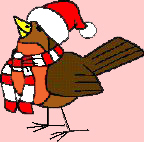
 Oct 15 to Mar 15:
Oct 15 to Mar 15: